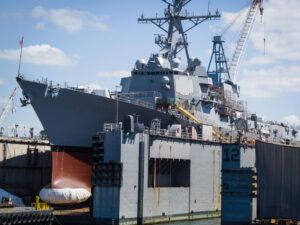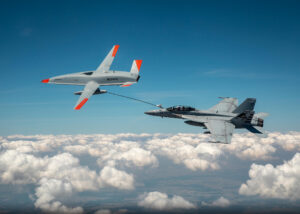The United States and other nations dependent on maritime trade for prosperity often forget about the power of the sea mine to inflict significant strategic and operational level of war effects on opponents. While the U.S. Navy has occasionally built back its mine clearance forces since the end of World War II, its mining capability and that of the wider joint force has been rarely used since 1945.
In fact, the nation’s mine infrastructure is facing a historic nearly-40 plus year period of neglect and under-investment since the end of the Cold War. This decay also includes industrial capacity, explosives, training, infrastructure, ships and personnel..
Just a handful of facilities, including those run by Boeing and General Dynamics in the U.S., produce mines. Like other neglected elements of U.S. munitions production, these facilities produce few dozen mines per year, a completely insufficient number for large-scale mining in the Indo-Pacific and other regions.
These historical examples show the power of relatively simple sea mines to change to course of campaigns and entire conflicts.
World War I
In 1915, a small number of mines can end an entire campaign and cause strategic effects. Just 20 mines laid by the Turkish minelayer Nusret sunk two British battleships (Irresistible and Ocean,) the French battleship Bouvet, and caused severe damage to the battlecruiser Inflexible while the ships were attacking the Dardanelles.
As a result, the British and French fleets suspended their attack on the Turkish fortifications guarding the strait and paused to wait for ground troops to take the Dardanelles. This campaign ultimately failed. Russia, unable to move grain outside the Black Sea suffered economic damages that helped foment the 1917 Bolshevik revolution and Russia’s exit from World War I.
World War I also saw the U.S. Navy deploy mines on a mass scale for the first time. The North Sea Barrage was a field of over 70,000 mines deployed in a relatively short period of time as a deterrent against German U-boats sailing around the British isles to get into position to attack convoys in the Atlantic.
While the campaign is credited with destroying only six U-boats, it cost less to accomplish than the value of losses in merchant ships in just one month of the war. German submarines were deterred from trying to penetrate the blockade, and their absence from the sea lanes ensured that supply from North America to the Allied forces in France and Belgium could continue.
World War II and the Vietnam War
Sea mines can cause direct strategic effects as well. In World War II, mines laid by U.S. Army Air Force aircraft sank almost 700 ships in the aptly named Operation Starvation, an effort that helped to hasten the end of World War II in the Pacific by starving Japan of oil and food exports from its remaining imperial possessions.
That mining campaign had operational effects as well. The lack of oil supplies in Japan forced the Japanese navy to divide its fleet before the U.S. 1944 invasion of the Philippines, an action that forced the Japanese into a complex scheme to link their distributed fleets to oppose the U.S. invasion. This effort, the Sho-Go plan, failed due to the inability of the Japanese to achieve fleet mass enough to defeat U.S. naval forces. The Imperial Japanese Navy suffered such heavy losses in the Battle of Leyte Gulf that it ceased to be an effective fighting force.
Mining can also force negotiated end to conflict. Throughout the Vietnam War, the U.S. had sought to interdict supplies being brought into South Vietnam by National Liberation Front guerrilla forces and into North Vietnam, with much if that coming from the Soviet Union.
This effort became much more challenging after 1970 when the Nixon administration sought to end U.S. involvement though “Vietnamization” of the conflict. In a move to force North Vietnam into political negotiations to end the war, the U.S. extensively mined North Vietnamese harbors, most notably that of Haiphong which was the main supply port for the North Vietnamese capital of Hanoi.
The mining campaign was so successful that no ships (Chinese, Soviet of North Vietnamese,) challenged the minefields.
The 1980s and Post-Cold War
Mining campaigns continued to have strategic and operational effects into the 1980’s and after the Cold War’s conclusion. In the early to mid-1980’s the Iran/Iraq war saw multiple attacks on merchant shipping, but “it was the resort to mine warfare by the Revolutionary Guard Corps Navy (IRGCN) that would change the nature of the tanker war and draw the U.S. Navy into direct conflict with Iran at sea.”
The U.S. had already undertaken Operation Earnest Will, a reflagging and escort mission for Kuwaiti tankers in 1987 when USS Samuel B Roberts struck an Iranian mine on April 14, 1988. The U.S. response in Operation Praying Mantis sank two Iranian surface combatants and damaged others, effectively driving Iranian naval forces out of many parts of the Persian Gulf for several years.
In 1991 during Operation Desert Storm, the threat of Iraqi mines caused a significant buildup in coalition mine clearance forces and general caution in operations because of events like the USS Samuel B Roberts mining in 1988. A planned amphibious assault on the Iraqi-occupied, Kuwaiti Faylakah island by Marines as part of Operation Desert Storm in 1991 was cancelled due to fear of Iraqi sea mines. Iraqi mines inflicted the most serious damage on U.S. naval forces as well in the mining of USS Tripoli and USS Princeton.
The way forward with mines
U.S. mining operations have been almost forgotten since the end of the Cold War. The existent Navy mine stockpile, like so many munitions, is small and aged, consisting of the Vietnam-era, but modernized, air-dropped Quickstrike mine and the developmental Hammerhead submarine-launched mine designed to replace a predecessor that entered service in 1983.
The U.S. may have as many as 10,000 stockpiled mines, but many more such weapons will be needed in order to create meaningful barriers to adversary action. Modern mines are more effective than those of the past, but large numbers will still be required if the U.S. would desire to close parts of the Indo-Pacific to Chinese surface ship and submarine passage.
The Air Force B-52 bomber played a role in the Cold War Maritime Strategy as a minelayer and retains that capability. Combined with unmanned surface and subsurface units to deploy them, modern mines could rapidly serve to deny contested areas of battlespace to an opponent, protect the U.S. homeland from submarine-based attack, and even threaten adversary home waters.
Mine warfare training and exercises have been overly focused on mine clearance, not minelaying. New joint exercise programs need to include mining by a diversity of platforms, including unmanned systems to integrate this capability back into the force. Increases of $5 million to $10 million a year in offensive mining capability and ordnance will not make up for lost decades of knowledge, production, training.
Mines have been weapons that wait for centuries, but the U.S. Navy can no longer wait to purchase more existent mines and make the new Hammerhead mine fully operational. Offensive mine warfare can help to contain adversary offensive action in multiple theaters and needs attention to again become a joint capability.
Mines are a joint force equalizer that the U.S. can no longer ignore.







